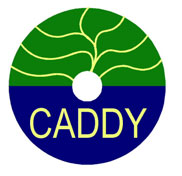CADDY V2 (legacy format)
Important notice
The CADDY V2 standard is outdated and no longer maintained since 2012. Please do not use the CADDY V2 format and corresponding software tools for productive use. Existing legacy dossiers in the CADDY V2 format should be immediately converted to CADDY-xml using the CADDY converter. The following information is provided as reference only.
Description
CADDY V1.1 and CADDY V2 are the predecessor formats of the current CADDY-xml format. Those formats – also named as “Classical CADDY” are no longer supported. The support of the legacy CADDY software for CADDY 2.0 has ceased at the end of 2012. The software can still be downloaded and used (check your download page that you receive after your registration), but there will be no further maintenance of the software (e.g. platform support for Windows versions later than Windows XP).
The further use of CADDY 2.0 format and software is not recommended. Industry and authorities are strongly encouraged to implement a direct production and usage of dossiers in the CADDY-xml format. Existing CADDY 1.1. and 2.0 dossiers that are kept for archiving purposes should therefore be converted to CADDY-xml using the CADDY converter.
History
To facilitate the newly established Directive 91/414/EEC procedure for (re-)registration of plant protection products CropLife Europe, the EU Commission and the European Member States agreed in 1995 to jointly develop an electronic standard for the submission of plant protection dossiers in Europe under the acronym “CADDY”.
The “Joint EU Member States / CropLife Europe Data Transfer Steering Group” consisting of five experts from European Member States, a representative from the EU Commission and five experts from CropLife Europe was established in June 1995 to work out a solution to meet their strategic goals:
- the provision of dossiers for pesticides to regulatory authorities
- the long-term archiving of such dossiers
- and the accessibility of information contained in such dossiers in a cost-effective manner using electronic media.
The original CADDY format specification was developed in 1995 in order to provide an effective electronic transport medium for complete submissions from the applicant to the reviewer. At that point, study reports used for the preparation of submissions existed primarily in paper form in an archive or as paper scans in an electronic archive. The first CADDY specification was deliberately kept simple, to allow rapid implementation of a robust system and in a cost-effective manner using electronic media.
These strategic objectives have been largely achieved in Europe, with electronic submissions in the CADDY format now the norm and the number of paper dossiers distributed to EU member states significantly reduced.
In 2000, CADDY was already commonly used in Europe for the submission and review of new substances. However, CADDY also plays an important role in the European review program where in addition to new submissions a large number of dossiers for existing substances have been submitted in the CADDY format. Early 2001, the Standing Committee on Plant Health decided that submission of electronic dossiers (CADDY only) should be encouraged for the review program.
As a next step, an additional strategic objective of providing optimized support for the examination and assessment of dossiers by regulatory authorities was added. A driving force for the development of CADDY-xml has been the need to integrate the dossier submissions with the internal information systems of regulatory authorities.
Over the past 10 years, document management technologies have evolved considerably and XML-based web technologies have become standard. Applicants are increasingly storing study reports in native electronic formats (i.e. without scanning step). Also, additional electronic format – other than TIFF – suitable for long-term storage of documents have emerged and become ISO standards, such as PDF/A.
In spite of its success in replacing paper dossiers in Europe, the uptake of CADDY has been limited to agrochemicals in Europe, with other regions pursuing a different approach based on PDF. The CADDY standard, therefore, needs further development to make it useful as a tool for dossier and data exchange in the context of global work sharing, as it is currently being promoted by OECD. In addition, there is a clear trend towards more structured data submission based on OECD templates which needs to be appropriately supported by modern technology.
For this reason, the CropLife Europe eSEG group started work with the EU Commission and some EU member states to further explore a more flexible development of the CADDY standard which then lead to the current CADDY-xml standard.
WARNING
Please do not use the CADDY V2 format and corresponding software tools for productive use! The downloads for CADDY V2 are provided for reference only!
The following free license key may be used by everyone for the CADDY Retrieval Software 2.0:
| Company Name | Free User |
| License Key | 4833-1001-MQDKHHJQ |
Please enter the Company Name and License Key exactly as stated above, considering capital letters.
